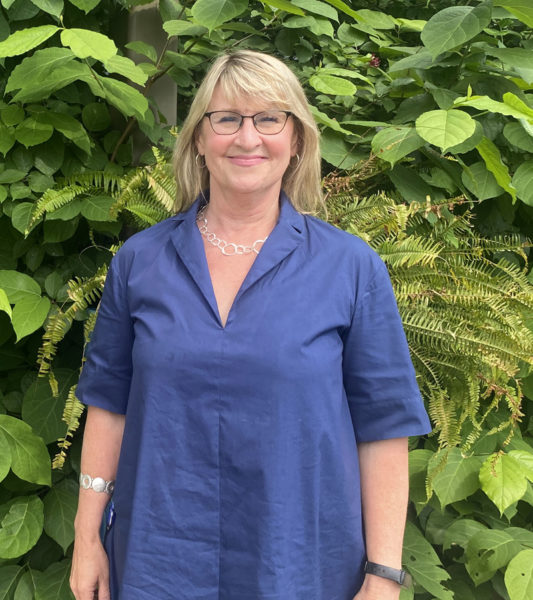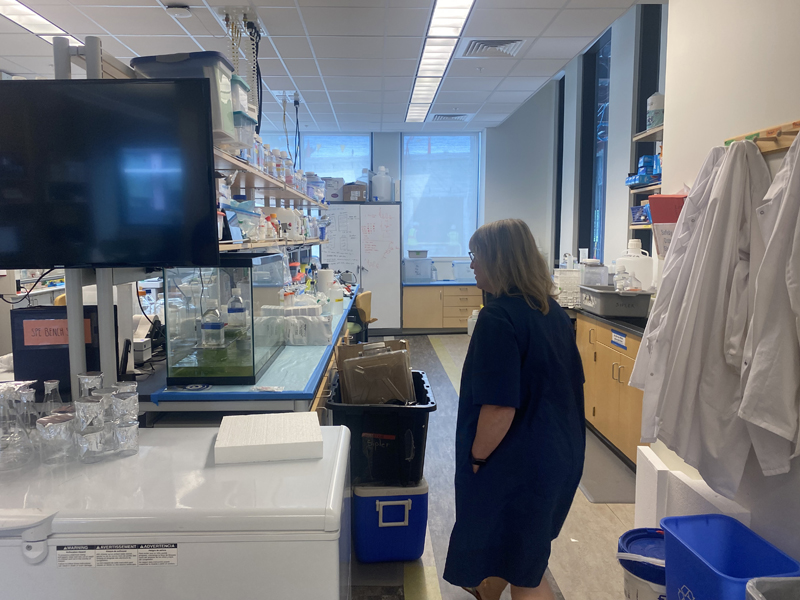
Dr. Deborah Bronk, president of Bigelow Laboratory for Ocean Sciences, stands in front of the lab in East Boothbay. Bigelow focuses on researching the base of the ocean food web, using the Gulf of Maine as a “natural laboratory.” (Frida Hennig photo)
The Gulf of Maine is not only home to lobsters and oysters, but also millions of phytoplankton, the ocean dwellers that Boothbay’s Bigelow Laboratory for Ocean Sciences concerns itself with.
Founded in 1974 by oceanographers Charlie and Carice Yentsch, the nonprofit research institute is celebrating its 50th year, and continues to lead the charge in researching ocean microbes.
“I don’t know if there’s been a lab in the world that’s had a bigger fingerprint on the study of ocean microbes than Bigelow has, especially for its size,” said Dr. Deborah Bronk, the current president of Bigelow.
“It’s a lab run by scientists for scientists, where people can really focus on research.”
Compared to other marine institutes, Bigelow has a very narrow focus. “We study organisms at the base of the ocean food web. It all starts with phytoplankton,” Bronk said.
Bigelow’s location on the east side of Boothbay provides a front row seat to observe ocean warming, its effects on phytoplankton, and subsequent economic effects.
“The Gulf of Maine, unfortunately is a perfect natural laboratory right now because it’s warming so fast,” Bronk said. “We’ve done experiments looking at how those changes might impact, say, the lobster and the lobster industry. … You don’t get a lobster or a whale if you don’t have a whole lot of phytoplankton.”
Bigelow’s communications specialist, Leah Campbell, spoke about how one of the values and goals of the institute is to understand “how the base of the food web has direct economic implications.”
Many of the scientists at Bigelow are focused on the bigger picture and how their research may affect the world. They are not only interested in understanding a problem, but they want to know how to fix it. This involves pursuing more applied aspects of research, not just basic research questions.
In terms of other institute values, Bronk praised the collaborative nature of Bigelow. “You want to create an environment where people feel supported, where people are challenged, and where people are inspired,” she said.
Bigelow’s system of bringing in revenue relies on everyone to support each other. If scientists don’t bring in grants, they aren’t able to conduct research, and the lab isn’t successful.
“It’s this whole intertwined network where people want each other to be successful, because otherwise this place isn’t successful,” said Bronk. “We don’t sit on an endowment. We’ve got to bring it every day.”
While Bigelow’s research does show the negative impacts of ocean warming, Bronk still remains hopeful for the future of ocean science.
“If we have smart creative people that are supported and have the resources to follow what they’re discovering and envisioning, everything’s going to be okay,” Bronk said.
Bigelow’s impact on the world of ocean science is mirrored by their state of the art lab in East Boothbay, which overlooks the Damariscotta River. The building features offices and labs, which hold instruments that can count and sort individual cells, for example.
“You used to be able to do oceanography on a shoestring, and now to really push the envelope of what we know, we need expensive instruments and they need skilled scientists just to run those instruments,” said Bronk.
Bigelow’s lab has three wings, and a fourth wing is under construction. Bronk hopes that this wing will provide more space for classrooms and teaching labs, as well as space for four more research scientists and their teams.

Dr. Deborah Bronk stands in one of Bigelow’s labs at the institute in Boothbay. Bigelow has 120 scientists conducting research, and just sent off their summer interns after weeks of working in the research labs. (Frida Hennig photo)
Bigelow currently has about 120 scientists conducting research, either in the Gulf of Maine, or at their discovery centers around the world.
The new classroom space in the fourth wing will hopefully enhance Bigelow’s already flourishing summer intern program. “I will bet you money that every one of those students is going to go on to be a scientist,” said Bronk of the most recent group of summer interns, who just finished their intern presentations and left the lab.
Although the program is difficult, said Bronk and Campbell, it teaches the interns how to think like researchers.
“We will turn you into a scientist,” Bronk said.
Bronk’s hopes for the new wing also include providing education for local high school students.
“I would love to have upper division classes from the high school come to do some of their work here,” Bronk said. “We really are an international, global institution. We want to work all over the world, but we also appreciate that Maine is our backyard, and what can we do to take advantage of being here, and also give back to Maine communities.”
To learn more about Bigelow Laboratory for Ocean Sciences, go to bigelow.org.



